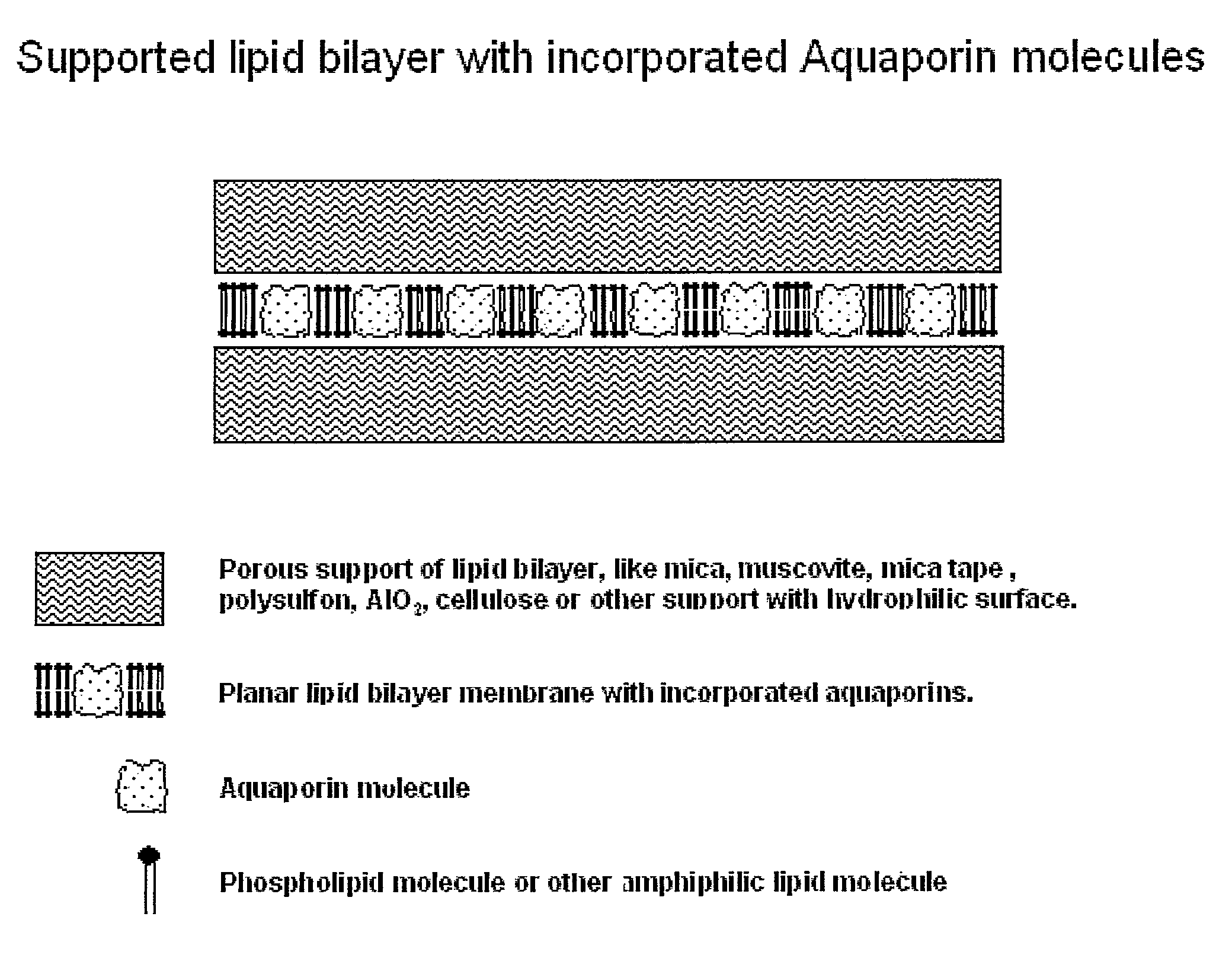Membrane for filtering of water
a membrane and water filter technology, applied in the field of new membranes for water filtering, can solve the problems of inability to clean and replace, the specifics of ultra-pure water become increasingly strict, and the surface of the membrane is foul, so as to achieve efficient water purification and desalination of seawater
- Summary
- Abstract
- Description
- Claims
- Application Information
AI Technical Summary
Benefits of technology
Problems solved by technology
Method used
Image
Examples
example 1
Reconstitution of AQP-1 in DPPC Lipid Vesicles (Proteoliposomes)
[0366]The following protocol has been used to prepare a water membrane according to the invention.
1. Preparation of Small Unilamellar Vesicles (SUVs)
[0367]a. Dry DPPC lipid is suspended in milli-Q water to obtain a concentration of 1,3-1,5 mM.[0368]b. The suspension is hydrated by incubation at 55° C. for 1 hour resulting in multilamellar vesicles (MLVs)[0369]c. SUVs are prepared by extruding the MLV solution 12 times through two 100 nm polycarbonate filters[0370]d. The SUV solution is stored at 55° C.
2. Preparation of BioBeads™ (Polystyrene Beads)[0371]a. Approx. 4 g BioBeadsTm are rinsed 5 times with milli-Q water[0372]b. The rinsed BioBeadsTm are sonicated for 1 hour under water suction
3. Reconstitution[0373]a. An appropriate volume of the SUV solution is pipetted into an eppendorf tube[0374]b. 50 μl 20% Triton X-100 is added[0375]c. 10 μl AQP-1 in denaturated form in a phosphate buffer purified according to the meth...
example 2
Formation of Lipid Bilayer and Possibly Further Multiple Bilayers on Porous Muscovite Mica to Obtain a Water Membrane as Schematically Illustrated by FIG. 1
[0383]1. A piece of muscovite mica (appr. 1 cm2) is cleaved with tape.[0384]2. Immediately after cleavage 25 μl of the proteoliposome solution from Example 1 is applied to the mica surface.[0385]3. The sample is incubated for 10 minutes at room temperature (21° C.) to form the fused bilayer.[0386]4. After incubation the sample is rinsed 7 times with Milli-Q water to remove excess unbound vesicles.[0387]5. Finally a freshly cleaved second piece of muscovite mica is deposited on the formed lipid bilayer.
example 3
Reconstitution of AQP-1 in E. Coli Lipid Extract Vesicles
[0388]E. coli total lipid extract in chloroform was obtained from Avanti Polar Lipids, (Alabaster, Ala.). Solvents (Chloroform, Ethanol, Methanol, Decane) were all purchased from Sigma-Aldrich (St. Louis, Mo.). SM-2 BioBeads were purchased from BioRad Laboratories (Hercules, Calif.). The water used in all preparations was ultrapure Milli-Q water (18.2 MΩcm-1). Aquaporin-1 purified from bovine erythrocytes was obtained as a suspension of unfolded protein from Dr. Jan Enghild, University of Aarhus.
[0389]Chloroform was evaporated from the lipid solution and the dry lipid film was hydrated with 100 mM KCI for 30 min. at 55° C. The solution was vortexed, and small unilamellar vesicles (SUVs) were formed by passing the solution 12 times through two 100 nm polycarbonate filters in a Lipex extruder (Northern Lipids, Vancouver, CD). The reconstitution mixture was prepared by adding Triton X-100 (Sigma) to a final concentration of 1.25%...
PUM
 Login to View More
Login to View More Abstract
Description
Claims
Application Information
 Login to View More
Login to View More - R&D
- Intellectual Property
- Life Sciences
- Materials
- Tech Scout
- Unparalleled Data Quality
- Higher Quality Content
- 60% Fewer Hallucinations
Browse by: Latest US Patents, China's latest patents, Technical Efficacy Thesaurus, Application Domain, Technology Topic, Popular Technical Reports.
© 2025 PatSnap. All rights reserved.Legal|Privacy policy|Modern Slavery Act Transparency Statement|Sitemap|About US| Contact US: help@patsnap.com



